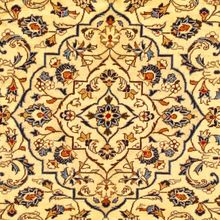Ardekan Rug
| Ardekan Rug | |
|---|---|
 Design of Ardekan Rug (Rugman) | |
| General information | |
| Name | Ardekan Rug |
| Original name | قالی اردکان |
| Alternative name(s) | Ardekan Carpet |
| Origin | |
| Category | City |
| Technical information | |
| Common designs | Medallion, Shah Abbasi |
| Common colors | Ivory, Beige, Red, Blue |
| Dyeing method | Natural, Synthetic |
| Pile material | Wool, Silk |
| Foundation material | Cotton |
| Knot type | Asymmetrical (Persian) |
Ardekan rugs originate from Ardakan, in the northwest corner of Yazd Province, known for its fabulous Persian carpets, is also historically a center of camel raising. Although it is located between Yazd and Nain, its influence comes primarily from Kashan. Throughout this area of Iran other small towns including Boroujerd, Josheghan, Khomaine, Najafabad, Taleghan, and Veramin, still weave Persian carpets with influences carried forward from the 16th century. Weavers from Ardekan use a Persian asymmetrical knot. Ardekan rugs woven in the larger cities are of the highest standards. Even though Ardekan rugs produced in villages tend to be of lesser quality than those produced in the larger cities, they are considered to be among the best in the world. It may take years for a dedicated artisan to produce a single rug.
History
Ardekan is a city located in the Yazd Province of central Iran. Ardekan carpets are known in the market from the 1920s, and were woven with a Kerman or Yazd design and technique. They were made with a cotton foundation and a wool pile. The Persian (asymmetric) knot was exclusively used. The designs are floral with either a medallion or an allover style. The motifs have palmette, leaf, and vine designs throughout the carpet. These carpets are marketed as Yazd or Kerman in the trade.
Because of low labor costs during the last quarter of the twentieth century, some Kashan and Nain manufacturers subsidized and assisted Ardekan weavers in making Nain and Kashan designs and styles. Ardekan weavers handled this change accord-ingly and made carpets in a wide quality range of medium to very fine in grade. The economic impact improved the daily lives for the people of Ardekan.[1]
See also
| Search for Ardekan Rug on Wikipedia. |
References
- ↑ Moheban, 2015, 63
Bibliography
- Abraham Levi Moheban. 2015. The Encyclopedia of Antique Carpets: Twenty-Five Centuries of Weaving. NewYork: Princeton Architectural Press.